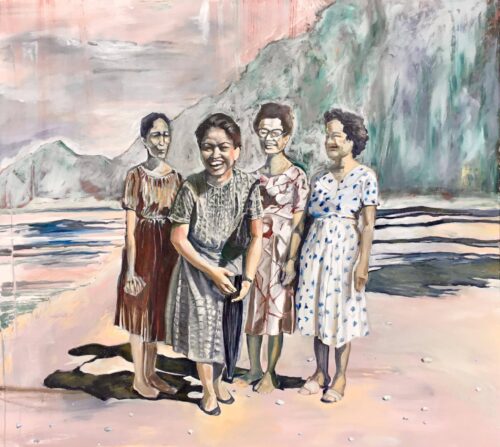Reflections on Filipino American History Month.
By SEGAN HELLE
“I don’t think that I’ve ever met a Filipino before.”
It was the first week of my freshman year. The chaos of move-in period had just begun to settle down and our parents had said their last goodbyes, leaving us in our room, sticky with the heat of a dying summer. My roommates and I were going through introductions, asking about each other’s backgrounds and sussing out who it was we would be living with for the next year.
“Well, I knew you were half some sort of Asian, but I wasn’t sure exactly what.”
I am used to explaining myself. My father is a white man and my mother is a first-generation Filipina-American. I do not quite look like either of them, landing me in solid ethnically-ambiguous territory. However, I am not used to living in an area in which my identity is not common.
I grew up in San Diego, California. San Diego County holds one of the largest Filipino communities in the United States, where Filipinos make up nearly half of the entire Asian-American population and are the largest Asian ethnic group. California itself is a hotspot for Filipino immigrants and families. According to the Pew Research Center, there are almost four million Filipinos currently living within the United States. Of those four million, roughly 45% of Filipino Americans live within California. Compared to my hometown, Boston’s Filipino population is miniscule. However, it was not until I moved away from the West Coast that I began to really learn about Filipino-American history.
In California, it was easy to take my culture for granted. Most of my friends were Filipino, so there was not a lot of purpose to ask each other questions about our histories. We ate lumpia and pancit together at parties. We sang karaoke late at night with our aunties. We already knew the stories of how our families came here through the navy or through nursing or medical work. Some of us had spent some of their earliest years on the islands. Others were second or third generation, like me, whose knowledge of the islands came from the stories of our parents or grandparents and whose families had intermarried or assimilated to American life.

It was not until I began getting questions from my friends on the east coast about Filipino-American heritage that I realized that I did not know much about the history. Even growing up in an area where many of my classmates and teachers had some Filipino blood in them, our stories were excluded from the lesson plans. The only time I remember a history book even acknowledging the existence of the Philippines is during a short section on the Philippine-American War. Despite the fact that Filipinos make up one of the largest Asian cultural groups in the United States, we are largely left out of the American narrative.
This month is Filipino American History Month (FAHM). According to the Filipino-American National History Society, FAHM was established by Congress in 2009. It is meant to remember the stories of Filipino-Americans since our first documented existence dating back to October 18, 1587, when the “luzones indios” were taken to northern California by Spanish colonists. It is meant to remember the lives lost to American imperialists during the occupation of the Philippines — of those whose villages were burned down during the Philippine-American War. It is meant to pay homage to the first large groups of Filipinos to immigrate to the United States, the pensionados, who traveled in order to attend school in the early twentieth century.
This is the time we remember Filipino laborers, who worked in Alaskan canning factories, Hawaiian sugarcane fields, and Californian farms. We remember Larry Itliong, who set the foundations for the 1965 Farmworker Movement and mobilized Filipino workers, but was forgotten by history books.
This is the time I think about my grandparents’ stories. I think about how my Lolo used to tell me tales about street-boxing and fishing in the waters of Rapu-Rapu and how he left his family behind to join the Navy and find a life in the United States — how his life fits into the larger narrative of a Filipino community built in San Diego by families who used the military as a ticket to escape. I think about my Lola, who told me that she had always wanted to fly in an airplane and had finally gotten the chance when she immigrated.
I think about my aunt and my uncle and about my family on the island that I still have not met. I think about my mom, and her paintings of our distant relatives on the shores of the Pacific an ocean away. I think about how the people in those paintings have my mom’s smile and how they are far but still familiar.
Segan Helle (shelle@college.harvard.edu) looks forward to learning more about Filipino-American history as the month goes on and would love to be eating lumpia right now.

